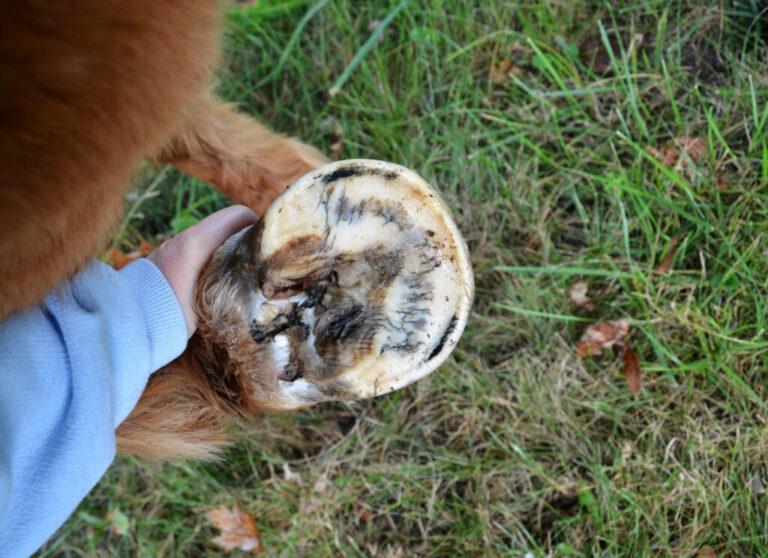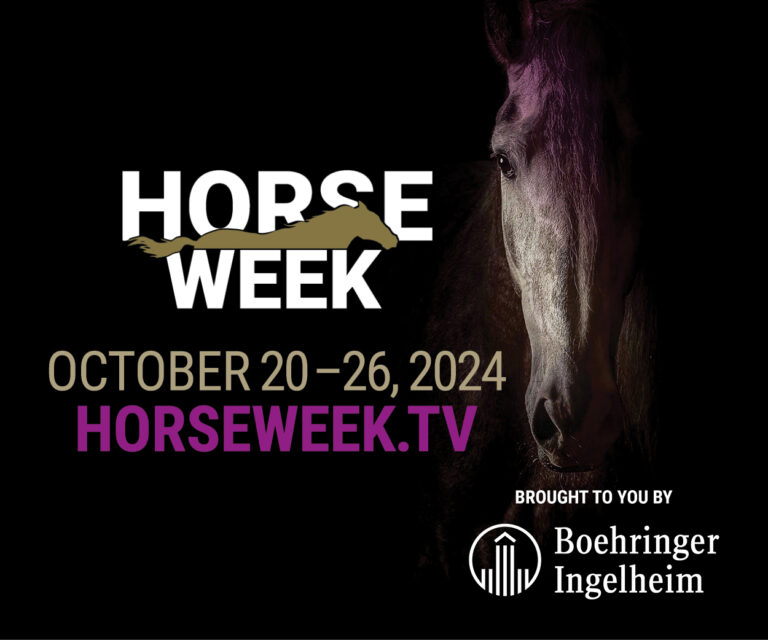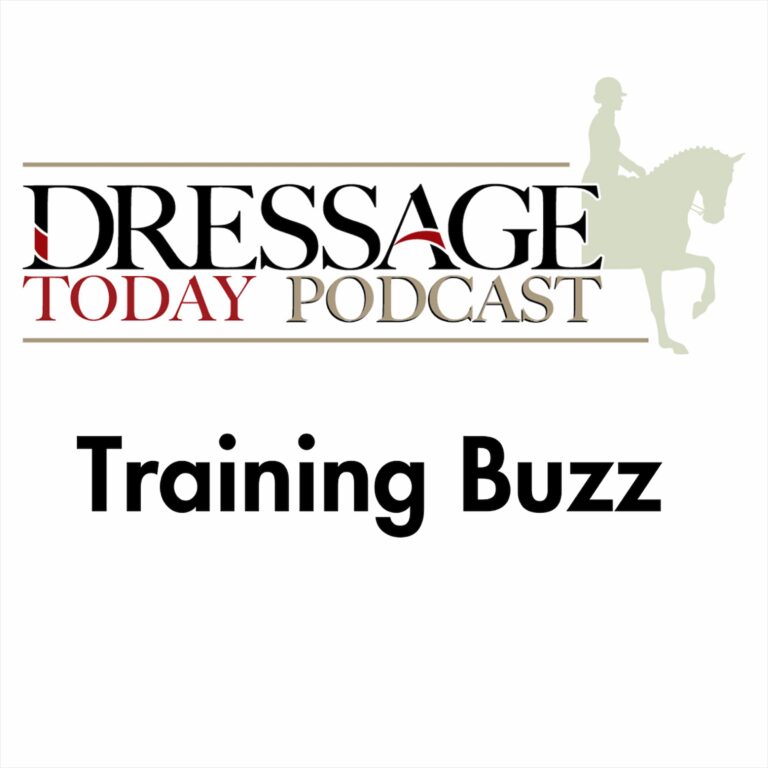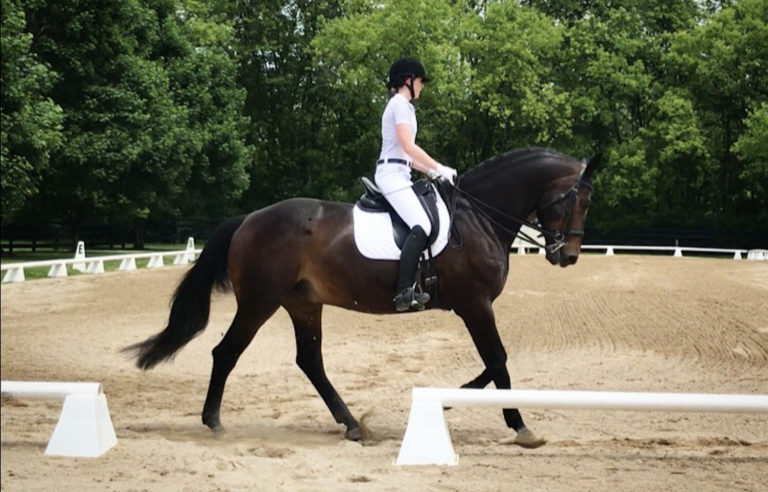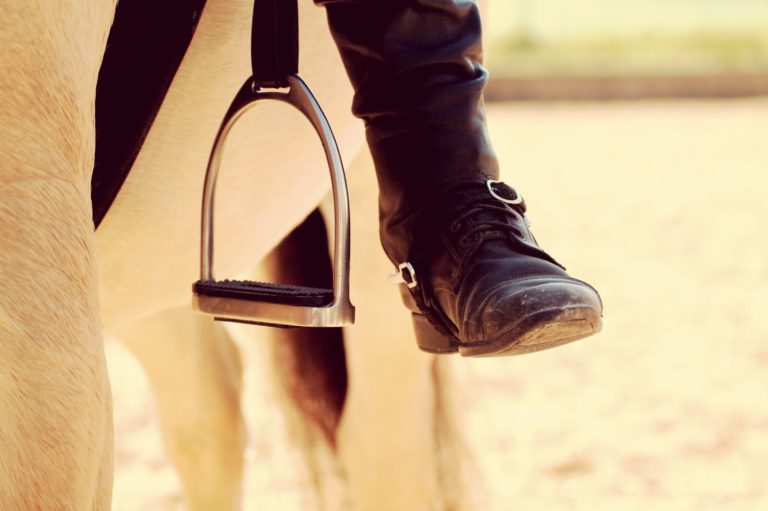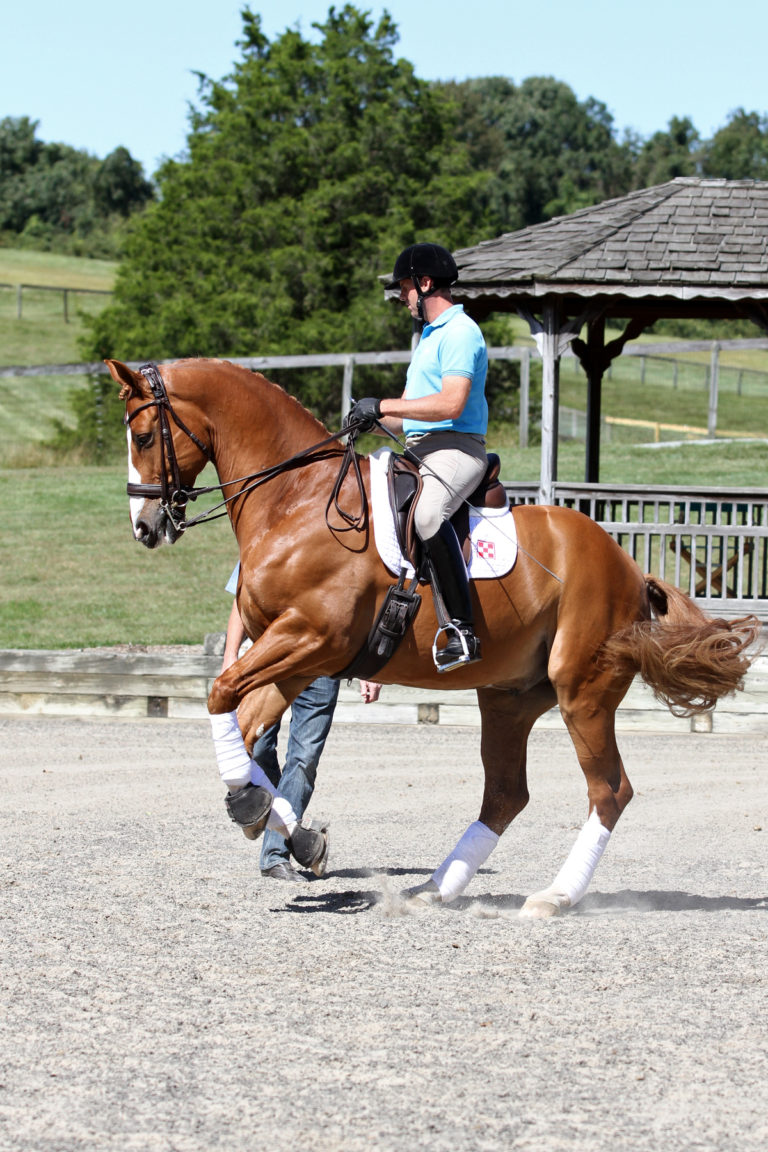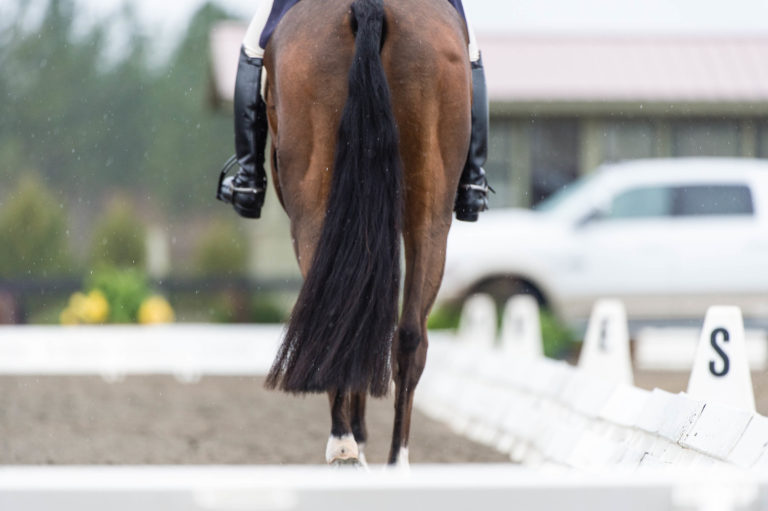Paris seems poised to host an amazing Olympic Games.
For equestrians, the Palace of Versailles venue has historic connections to horses and their place in European culture. It’s relatively easy to get to for most of eventing, dressage, show jumping and para-dressage’s power-player countries. The City of Light stages look ready to showcase equestrian sports at their finest.
The appeal of Paris, however, has nothing to do with why the United States’ 16 horses and riders will be there. They’re there to fulfill dreams drafted in childhood and realized through years of hard work, patience, persistence, broken bones, broken hearts, big bills, bad days and a million other things about which the rest of us have only a small inkling.

And they’re there because they had the right horse, the right plan to bring him along, the right backers and funding, and a National Federation focused on nurturing horses and riders at various levels of the ever-narrowing Olympic pipeline.
Given that we’re talking about horses—they probably had some old-fashioned good luck, too.
But first, let’s start with Paris …
Versailles as a Venue
It’s unlikely that U.S. equestrians will be among the 10,500 athletes floating down Paris’ Siene River in the Opening Ceremony for the 2024 Olympic Games. Especially the eventers. The procession is Friday, July 26, the same day as eventing’s First Horse Inspection and the day before their Games begin with dressage on Saturday, July 27.
But equestrians have a sweet venue to enjoy—the grounds of the Palace of Versailles. If you’ve visited King Louis XIV’s palace as a tourist, picture looking about two miles down the gardens and Grand Canal to the Park at Versailles. An arena on the Étoile Royale esplanade will stage eventing, dressage, show jumping and para-dressage.
Eventing’s cross-country phase will run up and down the Grand Canal and through the surrounding forests and grass expanses.
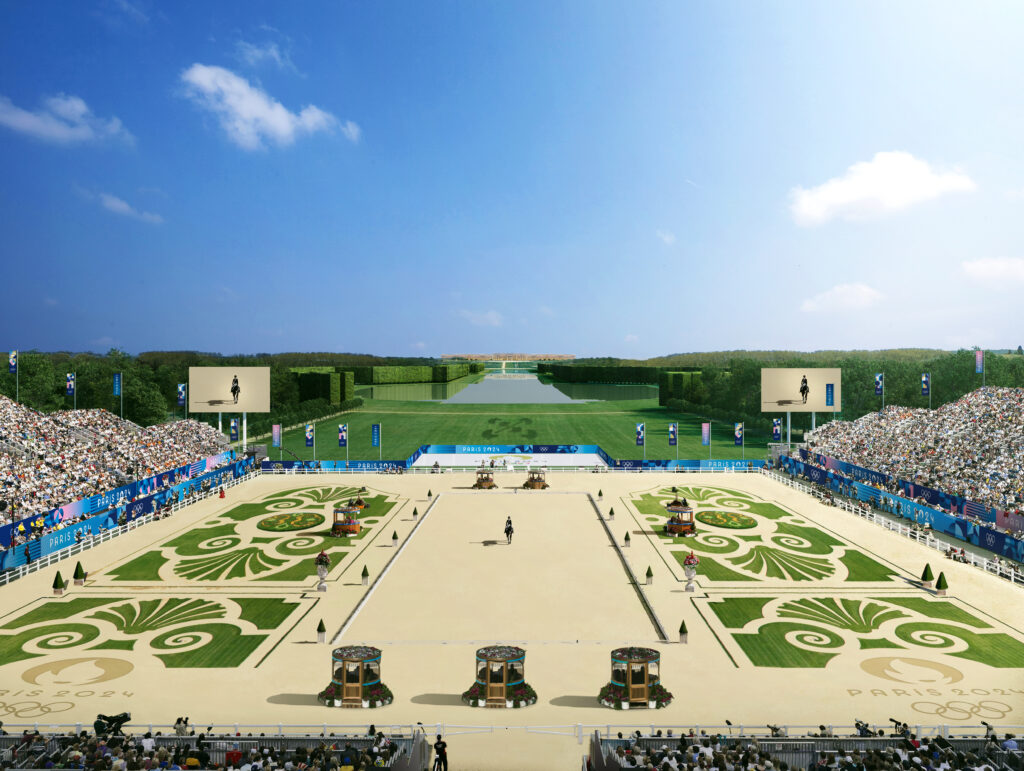
A UNESCO World Heritage site, Versailles perfectly fits the organizers’ desire to blend culture with sport. It’s about 21 miles from the Olympic Village in the heart of Paris, and it can take an hour to 90 minutes of travel time to reach.
King Louis XIV used the approximately 10,000-acre park as a getaway and to enjoy his own horses and equestrian activities. The Great Stables of the Palace of Versailles have been home to the National Equestrian Academy since 2003. Its Royal Stables are now a stage for the Academy’s artistic equestrian performances.
Competition Overview
Dressage and jumping teams did final tune-ups at European competitions, some of which were observation events that narrowed their short lists to the three horse-and-rider pairs, plus one traveling reserve.
The eventing team had a final observation event at Stable View in South Carolina in late June. Their next stop will be a training camp in Vittel, France, a week before the Games. They based there before the FEI World Championships, too.
Eventing, dressage, show jumping and para-dressage teams consist of three horse-and-rider pairs. As was first the case in at the Tokyo Olympics in 2021, all their scores count toward team standings—there’s no longer a fourth pair and the option of a “drop score.” A traveling reserve pair is on site and ready to go, but the rules and—in some cases—penalties for their deployment vary by discipline.
Dressage
Announced June 25, the U.S. Olympic Dressage Team is Adrienne Lyle and Helix, Marcus Orlob and Jane, and Steffen Peters and Suppenkasper. Endel Ots and Zen Elite’s Bohemian are the traveling reserve combination.
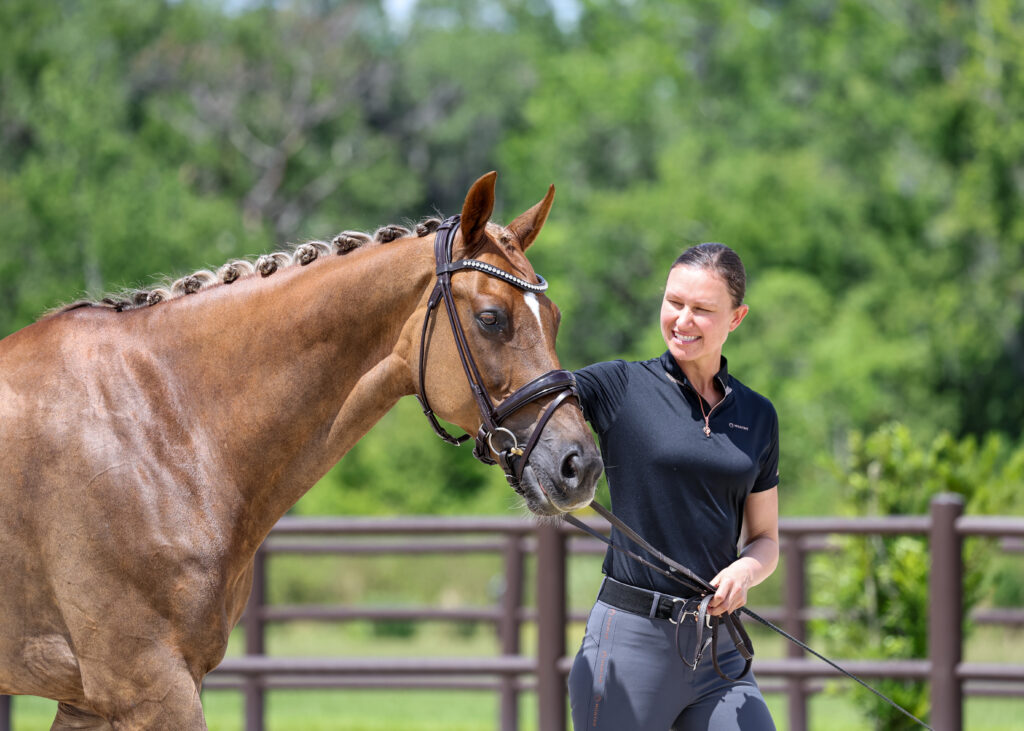
Coming off Tokyo’s historic silver medal, the U.S. dressage team will focus on returning to the podium starting with Paris and continuing on the road to Los Angeles 2028. Chef d’Equipe Christine Traurig says the same qualities that ultimately put pairs on the team will determine their success in Paris.
“In today’s view of our sport worldwide, it is the bond and harmony between the horse and the rider that needs to shine when a pair performs at the top of their potential and ability. It is the lightness, the ease, the seamless flow from movement to movement that makes a performance not only brilliant but also beautiful. That is what we strive for in our riders and horses, and they are known for it.”
The 45 team pairs representing 15 countries, and 15 pairs competing as individuals, begin with the Grand Prix test. It will take place over two days, Tuesday and Wednesday, July 30 and 31, with 30 rides each day.
The top-10 ranked teams in the Grand Prix next ride in the Grand Prix Special on Saturday, August 3, to determine the team medals. Then, the top-18 contenders who qualify for the Grand Prix Freestyle will compete for individual medals on Sunday, August 4.
Scores in the mid-70s and above are likely the minimum for making the team podium. In Tokyo, the team gold-winning Germans had an over 80% team average in the Grand Prix Special. The U.S.’ team silver resulted from a 78.490 average, with Sabine Schut-Kery and Sanceo securing the silver on a career-high 81.596.
The movements in the Grand Prix Freestyle that decide the individual medals offer the potential for higher scores. In Tokyo, Germany’s Jessica von Bredow-Werndl and Dalera earned gold with a 91.732. Her countrymate Isabell Werth and Bella Rose earned an 89.657 for silver. The U.K.’s Charlotte Dujardin and Gio earned bronze with an 88.543.
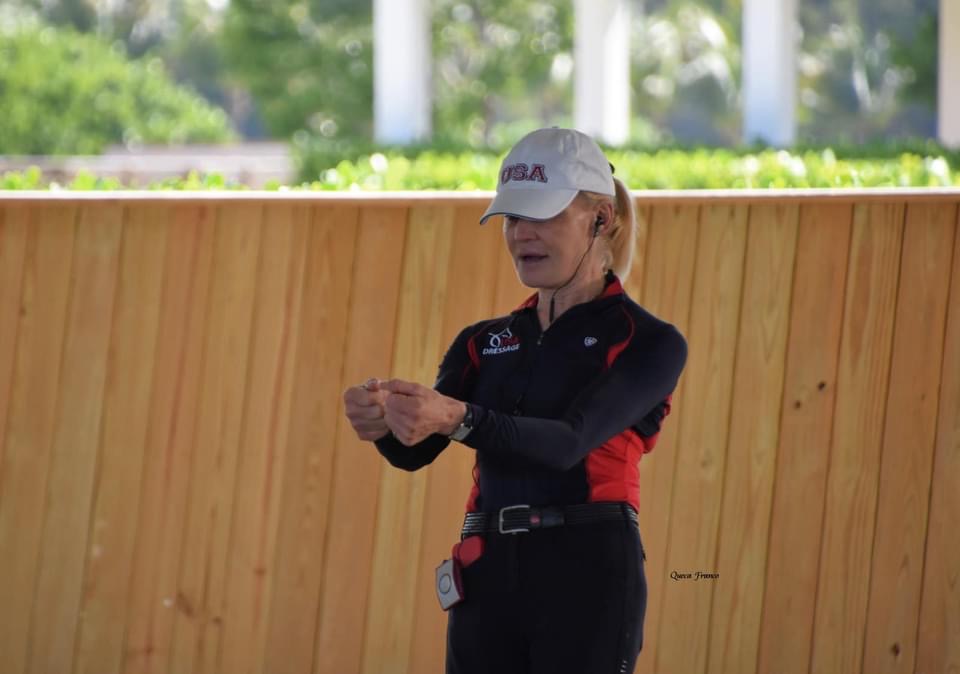
Except for potentially hot weather, Traurig expects no unusual challenges beyond the immense pressure of competing on the world stage. “It’s going to be spectacular, and it’s anticipated that Paris will welcome the most spectators ever at an Olympic Games,” she says. “The organizers will go out of their way to have everything perfect.”
The dressage competition schedule (subject to changes) is as follows:
| Day | Event | Paris/Central European Time (ET) |
| Sunday, July 28 | First Horse Inspection | 7:00 a.m. (1:00 a.m. ET) |
| Tuesday, July 30 | Team & Individual Grand Prix Day 1 | 11:00 a.m. (5:00 a.m. ET) |
| Wednesday, July 31 | Team & Individual Grand Prix Day 2 | 10:00 a.m. (4:00 a.m. ET) |
| Saturday, August 3 | Team Grand Prix Special/Team Final | 10:00 a.m. (4:00 a.m. ET) |
| | Team Medal Ceremony | 3:30 p.m. (9:30 a.m. ET) |
| Sunday, August 4 | Individual Grand Prix Freestyle/Individual Final | 10:00 a.m. (4:00 a.m. ET) |
| | Individual Medal Ceremony | 1:30 p.m. (7:30 a.m. ET) |
Eventing
Announced June 3, the U.S. Olympic Eventing Team is Will Coleman and Off the Record, Boyd Martin and Fedarman B, and Caroline Pamukcu and HSH Blake. Liz Halliday and Cooley Nutcracker are the traveling reserve. In addition, there are several alternates, including team riders considered “direct reserves” with a second horse.
The U.S. has a long history of international team and individual medals, but it’s been 20 years since their last team podium appearance at the Olympics—bronze in Athens in 2004. Team silver at the 2022 World Championships and the 2023 Pan Am Games to qualify for Paris put the team on pace to reclaim Olympic podium territory.
Chef d’Equipe Bobby Costello is confident the Paris squad has all the right stuff. Even before the team was announced, he said, “We will have the top horses and are fielding a very competitive team.”
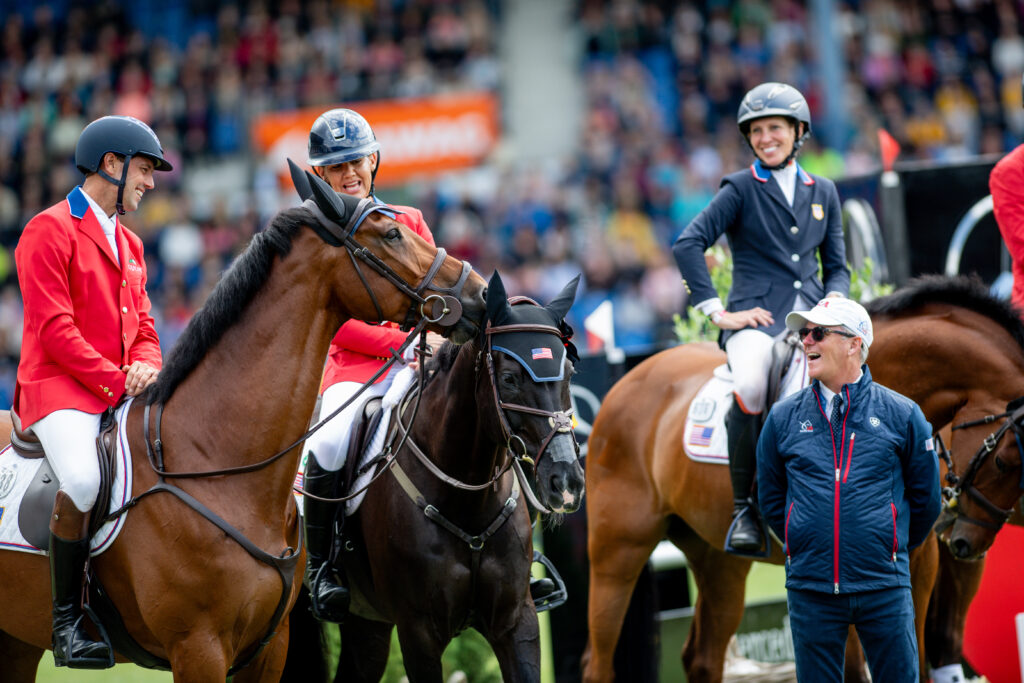
Paris will present a few new challenges. With all dressage going on one day, Saturday, July 27, there’s less time to walk Pierre Le Goupil’s cross-country track. But a compressed schedule is something all major players have dealt with at CHIO Aachen, Costello noted.
The third day of competition includes two jumping rounds. The first will determine the team medals. Then the top 25 from that round will come back for another round to determine individual medals.
Gregory Bodo of France and Santiago Varela of Spain will co-design Eventing’s stadium jumping finale. They’re also designing the courses for the show-jumping discipline.
Cross country will run up and down either side of Versailles’ Grand Canal, crossing it twice on temporary bridges constructed for the Games. Sharp turns and switchbacks are likely on the flat terrain, potentially favoring adjustability and nimbleness. “But I tend to feel that a great horse is a great horse who can compete over many different types of venues,” Costello observed.
The demands of Olympic eventing are basically five-star difficulty and scope for dressage and show jumping. For cross country, there’s only a slight step down in the width and number of jumping efforts involved. “It’s a very fine line,” Costello said.
Overall, a total of 16 teams made up of 48 athletes will compete for team medals. Team athletes will also compete for individual medals. An additional 17 individual athletes can compete for individual medals.
The eventing competition schedule (subject to changes) is as follows:
| Day | Event | Paris/Central European Time (ET) |
| Friday, July 26 | First Horse Inspection | 9:30 a.m. (3:30 a.m. ET) |
| Saturday, July 27 | Team & Individual Dressage | 9:30 a.m. (3:30 a.m. ET) |
| Sunday, July 28 | Team & Individual Cross Country | 10:30 a.m. (4:30 a.m. ET) |
| Monday, July 29 | Second Horse Inspection | 7:30 a.m. (1:30 a.m. ET) |
| Team Jumping Final & Individual Jumping Qualifier | 11:00 a.m. (5:00 a.m. ET) | |
| Individual Jumping Final | 3:00 p.m. (9:00 a.m. ET) | |
| Team & Individual Medal Ceremony | 4:00 p.m. (10:00 a.m. ET) |
Show Jumping
Announced July 6, the U.S. Olympic Show Jumping Team is Kent Farrington and Greya, Laura Kraut and Baloutinue, and McLain Ward and Ilex. Karl Cook and Caracole de la Roque are the alternate combination.
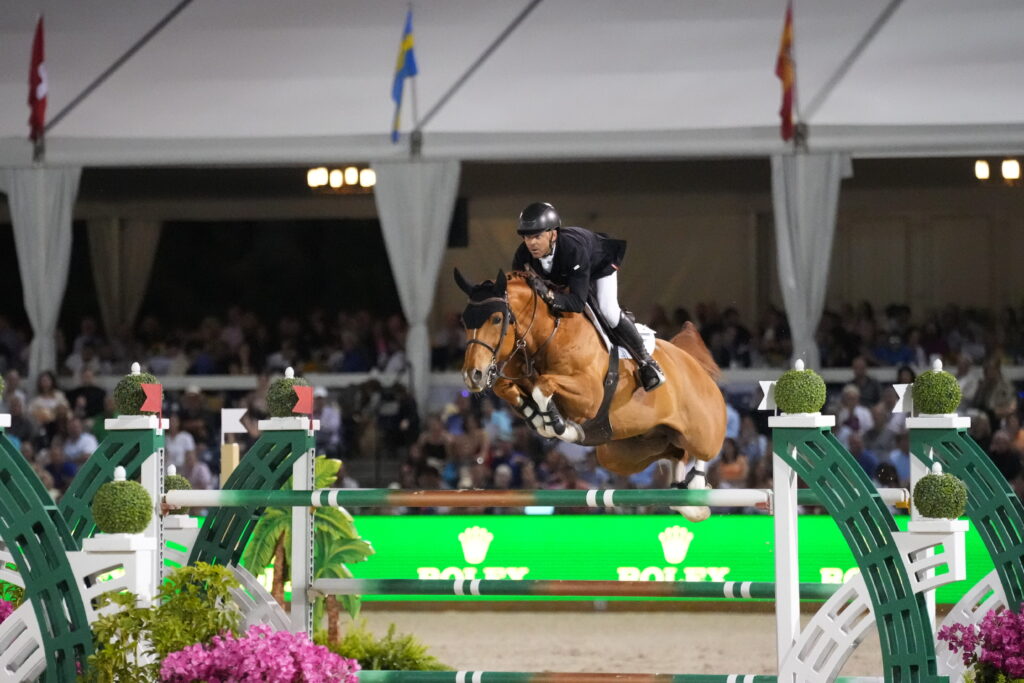
U.S. show jumping marches into Versailles with consecutive team silvers from Tokyo in 2021 and Rio de Janeiro in 2016. They also have a strong Olympic track record since 1960 team silver in Mexico City.
Thursday’s team qualifier will see three pairs from 20 teams tackling a Table A against-the-clock track. (In a Table A competition, faults are penalized in penalty points.) Up to 17 jumping efforts may vary between 1.40 and 1.65 meters, with at least two verticals measuring 1.6 meters. Spreads can hit 2 meters, and 2.2 meters for a triple bar. There is no jump-off in this team qualifier.
The top-10 finishing teams advance to the Finals on Friday, August 2, plus any teams tied on penalties and time for 10th place. All start with zero penalties.
Teams tied on penalties for first place will jump off in the team final round. Additionally, teams tied for penalties and time for third will jump off. In the final team standings, teams with three pairs completing will place over teams with only two pairs completing.
For the individual qualifier on Monday, August 5, 75 pairs may start—a maximum of three per country, plus those riding as individuals. Again, it’s Table A against the clock, with no jump-off to break ties of penalties and time. The top 30 pairs from this round start the individual final on Tuesday, August 6, with a clean slate. Ties on penalties for first place will jump-off, with the slower pair going first. Ties on penalties and time for third place will jump off before the jump-off for first.
Gregory Bodo of France and Santiago Varela of Spain will co-design the jumping tracks. Varela is highly regarded for his horse-friendly and dramatically beautiful courses for eventing’s jumping phase and show jumping in Tokyo.
The show jumping competition schedule (subject to changes) is as follows:
| Day | Event | Paris/Central European Time (ET) |
| Wednesday, July 31 | Horse Inspection (Team) | 7:30 a.m. (1:30 a.m. ET) |
| Thursday, August 1 | Team Qualifier | 11:00 a.m. (5:00 a.m. ET) |
| Friday, August 2 | Team Final | 2:00 p.m. (8:00 a.m. ET) |
| Team Medal Ceremony | 4:00 p.m. (10:00 a.m. ET) | |
| Saturday, August 3 | Horse Inspection (Individual) | 2:00 p.m. (8:00 a.m. ET) |
| Monday, August 5 | Individual Qualifier | 2:00 p.m. (8:00 a.m. ET) |
| Tuesday, August 6 | Individual Final | 10:00 a.m. (4:00 a.m. ET) |
| Individual Medal Ceremony | 12:00 p.m. (6:00 a.m. ET) |
Para Dressage
Under Chef d’Equipe Michel Assouline, the U.S. has earned unprecedented success. This includes team bronze and two individual golds for Roxanne Trunnell at the Tokyo Paralympics. Additionally, they earned team bronze at the 2022 ECCO FEI World Championships. In May of this year, the U.S. Para Dressage Team topped the podium at the Mannheim CPEDI3* in Germany. In early June, the team again won the top honors in the Hagen CPEDI3*.
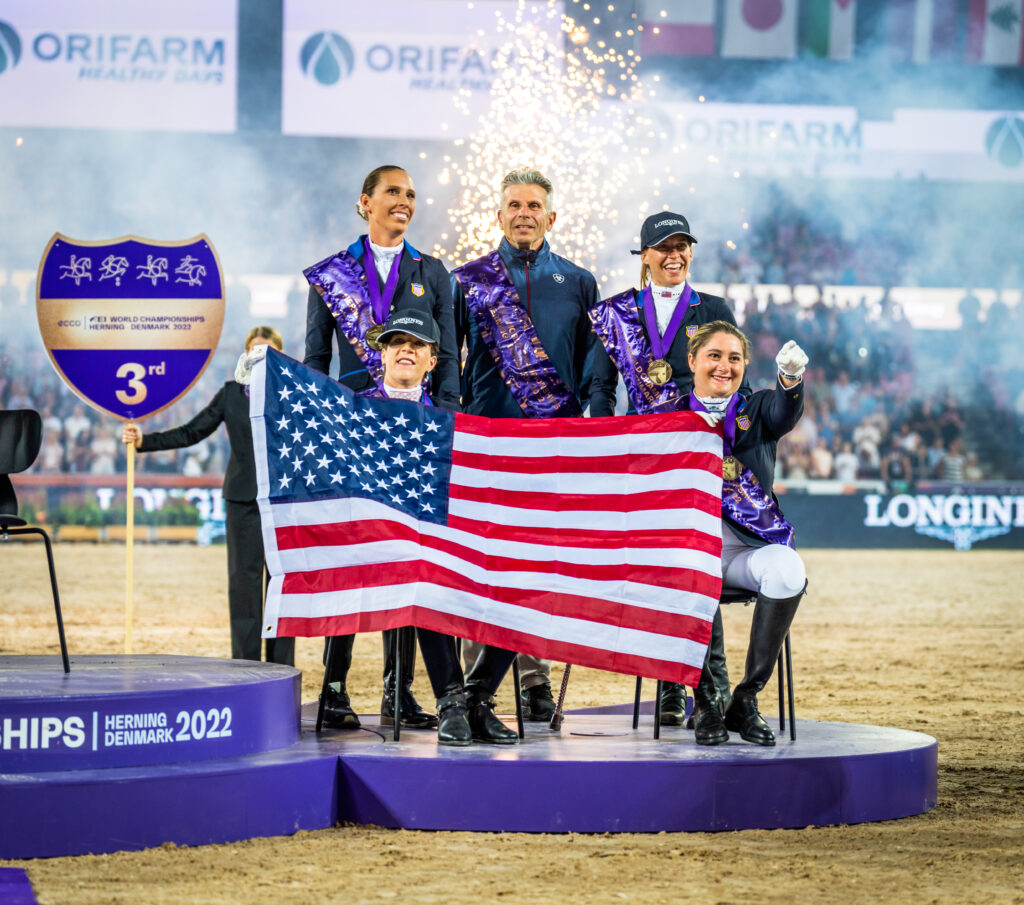
Para dressage is part of the Paralympic Games, which is August 28–September 8. The Paralympics’ one equestrian sport, para dressage, is four days of competition, September 3–7. One team member must be classified as Grade I, II or III—the most physically impaired of para dressage’s five grades. And the team may not include more than two riders from any Grade. In a team of four riders, only the top three scores will count for the team medal. Individual medals are determined by the results of the Para Grand Prix A and Para Grand Prix Freestyle. Team medals are determined by the Para Grand Prix B.
Announced July 12, the U.S. Paralympic Equestrian Team consists of Rebecca Hart and Floratina, Fiona Howard and Diamond Dunes, Kate Shoemaker and Vianne, and Roxanne Trunnell and Fan Tastico H. The three U.S. team combinations will be determined after the Para Grand Prix A Tests on Wednesday, September 4, 2024.
The para dressage competition schedule (subject to changes) is as follows:
| Day | Event | Paris/Central European Time (ET) |
| Monday, September 2 | First Horse Inspection | 8:00 a.m. (2:00 a.m. ET) |
| Tuesday, September 3 | Para Grand Prix A Test – Grades I, II, III/Individual Medal | 9:00 a.m. (3:00 a.m. ET) |
| Individual Medal Ceremony – Grades I, II, III | 5:37 p.m. (11:37 a.m. ET) | |
| Wednesday, September 4 | Para Grand Prix A Test – Grades IV & V/Individual Medal | 10:00 a.m. (4:00 a.m. ET) |
| Individual Medal Ceremony – Grades IV & V | 3:26 p.m. (9:26 a.m. ET) | |
| Friday, September 6 | Para Grand Prix B Test – Grades I, II, III, IV, V/Team Medal | 9:30 a.m. (3:30 a.m. ET) |
| Team Medal Ceremony | 6:17 p.m. (12:17 p.m. ET) | |
| Saturday, September 7 | Para Grand Prix Freestyle – Grades I, II, III, IV, V/Individual Freestyle Medal | 9:30 a.m. (3:30 a.m. ET) |
| Individual Freestyle Medal Ceremony – Grades I, II, III, IV, V | 5:00 p.m. (11:00 a.m. ET) |
The Logistics
Enabling the U.S.’ 16 horse-and-rider pairs to be totally in the moment on competition days requires years of advance planning from the U.S. Equestrian Federation’s support staff.
The to-do list ranges from booking flights and lodging or stabling to soliciting snack preferences from the riders. Nudging the many owners of potential team horses to complete a detailed accreditation process four months before their horse might strut its stuff in Paris is another of myriad items to be checked off the list.
The timetable for moving horses in and out of the stables is tighter than normal, said Hallye Griffin, USEF director of FEI Sport and chef de mission for the Olympics. The eventing horses, for example, need to be moved out by 10 p.m. on Monday, July 29, the same day as the team and individual show-jumping rounds and medal ceremonies.
And the move-out needs to be done with sensitivity toward the athletes’ experience, which looks different depending on whether they medal or not. “We focus totally on the medal competition and the horses and athletes that day,” Griffin noted. “We never do a tear down, take down the banners or pack up the vet truck, etc. until the competition is over.
“If we’re managing a victory, first off everyone wants to come to the barn,” Griffin continued. “There’s a very tight accreditation process and we need a clear plan to keep the barn a workplace. We decide and communicate where everyone would come to meet for a celebration, where the owners can come say hello to their horses. And we make sure the grooms feel a part of it.”
This year, the horses are stabled by discipline, not by country, adding a logistical layer to each discipline’s stable space. Grooms stay in organizer-provided on-site lodging, so they can get to their horse 24/7 if needed. Their well-being and support is critical to the U.S. team’s success, Griffin emphasized.
A seemingly mundane shipping container plays a key role in U.S. Equestrian Team success. In early May, it left New York filled with equipment—from pitchforks and wheelbarrows to coffee and panini makers.
At Versailles, the shipping container will likely be the team hub as it was in Tokyo. “It saved us in Tokyo,” recalled USEF’s Carly Weilminster, senior director of Sport Communications and Social Media. Athletes, grooms, physios and staff gathered to socialize, charge phones and stay cool in the air-conditioned unit.
Riders will stay in hotels near Versailles, not in the athlete village. Also, few are expected to participate in the Opening Ceremonies parade on July 26. However, team priorities include helping the athletes enjoy the full Olympic experience with watch parties and other activities.
“We want the athletes to be relaxed, rested and ready to perform, so everybody has a hotel with air conditioning,” explained Griffin, who will be on site in Versailles for three weeks. Shuttles to the venue were scheduled months ago with options for impromptu stable visits, too.
What’s at Stake?
Olympic preparation occupies a huge part of the USEF staff’s time and lives, even though many of their roles also serve lower levels of the sport on a year-round basis. Olympic success drives a lot of what happens with the much wider base of equestrian sport in the States.
“A lot of the work that happened around Tokyo and the success there helped drive our membership,” noted Griffin. Memorable moments include videos of the grooms helping horses on their flights to Tokyo and the “Rave Horse” viral sensation around dressage stars Suppenkasper and Steffen Peters. Olympic exposure and success consequentially can be key to growing the fan and participant base.
They also play a role in improving the odds that equestrian sport keeps its place in the Olympics.
Equestrian has been part of the Games since 1900—fittingly in Paris—and have been continuously part of the Olympics since 1912. But the land and logistics involved in staging equestrian competition make it vulnerable. Popularity with fans and accessibility to participants around the world weigh heavily on any sport’s continued place in the Olympic Games.
Sidebar: A Groom’s Experience
Margo Thomas’ first Olympics was Tokyo in 2021, caring for Laura Kraut’s partner on the silver-winning U.S. team—Baloutinue. Tending to only one horse was the most tangible difference in her role at the Tokyo Games versus the usual five-star competitions.
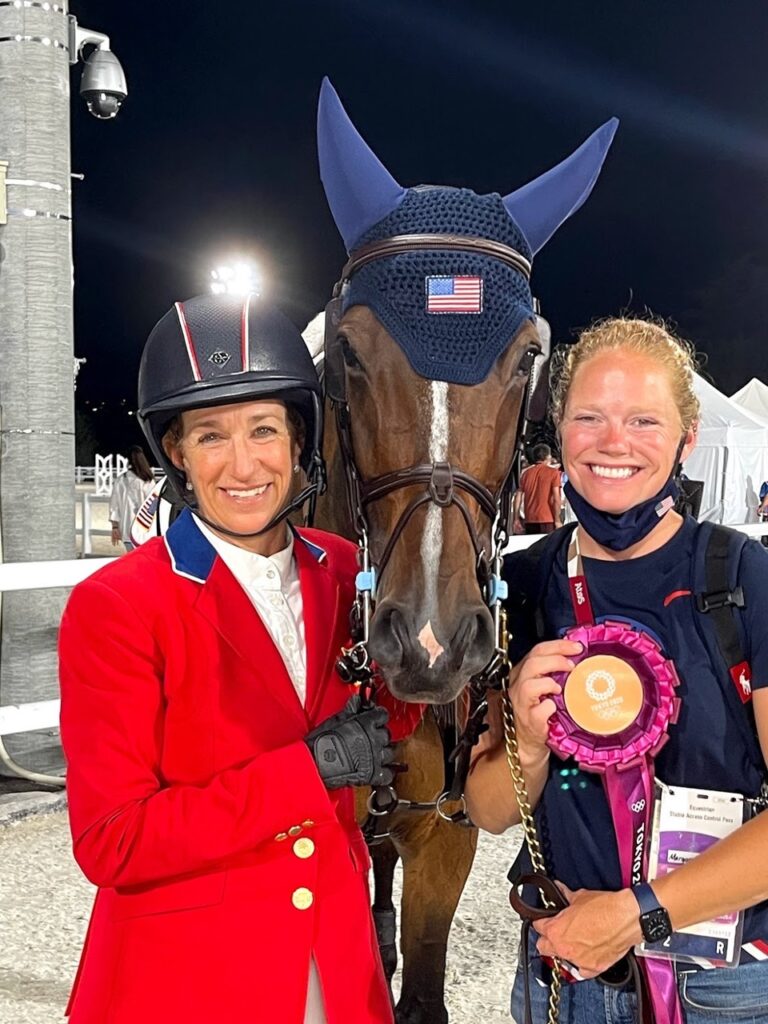
“You can pay every attention to detail to make sure everything is going to go right,” Thomas said.
The Olympics bring a new level of pressure. Evidently Thomas found herself managing it better after the first round of jumping in Tokyo. “Getting through the first night was a relief and made it easier to focus on the horse and not my own nervousness about being at ‘the Olympics!’
“I’ve learned over the years how important it is to keep my own emotions and jitters under control because I don’t want to bring that energy to my horse,” Thomas shared. “They’re empathetic creatures, and it’s better to take a deep breath and focus on the task at hand, try to let go of the pressure of what’s going on outside the stall.”
Other than getting their grooms’ time to themselves, the Olympic horses get their usual routines to every extent possible. “We try to follow all the same protocols and just make sure they’re happy and comfortable,” Thomas shared. Monitoring Baloutinue’s mood and behavior for anything unusual was a key task in Tokyo, as it is at other competitions.
Grooms lived on site at the venue in Tokyo, as they will at Versailles. “I was close enough that I could almost see the barn out of my window.”
Grooms need to be aware of FEI and, in some cases, Olympic-specific rules regarding approved tack and apparel. What bits, bridles and other tack, can be used was announced as set in stone a few months before the Games, and is accessible for double-checking on the FEI Horse App.
There’s strong camaraderie between grooms at the Olympic level thanks to friendships fostered on the international circuit. “You want your team to win at the end of the day, but I have friends who groom for other countries, and I am sometimes nearly as excited for them when their horse jumps a clear round.”
Check out more coverage of the Paris 2024 Olympic Games.
This article originally appeared in the Summer 2024 issue of Practical Horseman.


